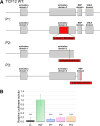Functional analyses of splice site variants in TCF12
- PMID: 40287710
- PMCID: PMC12034182
- DOI: 10.1186/s40246-025-00758-1
Functional analyses of splice site variants in TCF12
Abstract
Pre-mRNA splicing is a fundamental step in protein synthesis within a cell. Malfunctions during this process can lead to dysfunctional proteins and thus, to a variety of different human diseases. Mis-splicing can be caused by genetic variants influencing many different molecular processes, e.g. splice donor and splice acceptor site variants. Today, the consequences of these variants can be calculated via different in-silico programs. Due to the complexity of the splicing process, however, these predictions are not always correct and should not be used as stand-alone criteria for the classification of potentially disease-causing variants. Therefore, in case RNA from an appropriate tissue is not available additional in-vitro studies, such as a minigene splice assay, which allows functional analyses of potentially disease-causing variants, are necessary to demonstrate an effect on splicing. One example of a human developmental disorder occasionally caused by mis-splicing of transcripts is craniosynostosis. This congenital disorder is defined by the premature fusion of one or multiple cranial sutures in the neurocranium. To date, numerous mutation types in more than 50 genes which are involved in a broad range of different cellular functions and pathways have been associated with craniosynostosis. For instance, the TCF12 gene encoding the bHLH (basic helix-loop-helix) protein TCF12 (transcription factor 12) is linked to Craniosynostosis 3 (OMIM: 615314) which exhibits a Saethre-Chotzen (OMIM:101400) like phenotype. In this study, we report a pipeline for functional validation of potential splice site altering variants. First, we describe the identification of two novel genetic variants and revalidation of one previously described genetic variant in patients with craniosynostosis. According to in-silico predictions, the splicing of the corresponding transcripts is altered, and the variants are potentially disease causing. We subsequently classify the consequences of alterations in TCF12 experimentally. The suspected aberrant splicing was investigated via an in-vitro minigene splice assay. In two out of three variants, the in-silico prediction and in-vitro experiments were consistent. In all variants a significantly reduced transcriptional activity was demonstrated. In summary, the combination of in-silico prediction and functional assays allowed us to classify the variants as likely pathogenic without the need for additional patient material.
Keywords: Craniosynostosis; Minigene splice assay; Splicing; TCF12.
© 2025. The Author(s).
Conflict of interest statement
Declarations. Consent for publication: Not applicable. Competing interests: The authors declare no competing interests.
Figures




References
-
- Wilkinson ME, Charenton C, Nagai K. RNA splicing by the spliceosome. Annu Rev Biochem. 2020;89:359–88. - PubMed
-
- Wan R, Bai R, Zhan X, Shi Y. How is precursor messenger RNA spliced by the spliceosome?? Annu Rev Biochem. 2020;89:333–58. - PubMed
-
- Faustino NA, Cooper TA. Pre-mRNA splicing and human disease. Genes Dev. 2003;17(4):419–37. - PubMed
-
- Wimmer K, Roca X, Beiglbock H, Callens T, Etzler J, Rao AR, et al. Extensive in Silico analysis of NF1 splicing defects uncovers determinants for splicing outcome upon 5’ splice-site disruption. Hum Mutat. 2007;28(6):599–612. - PubMed
MeSH terms
Substances
LinkOut - more resources
Full Text Sources

